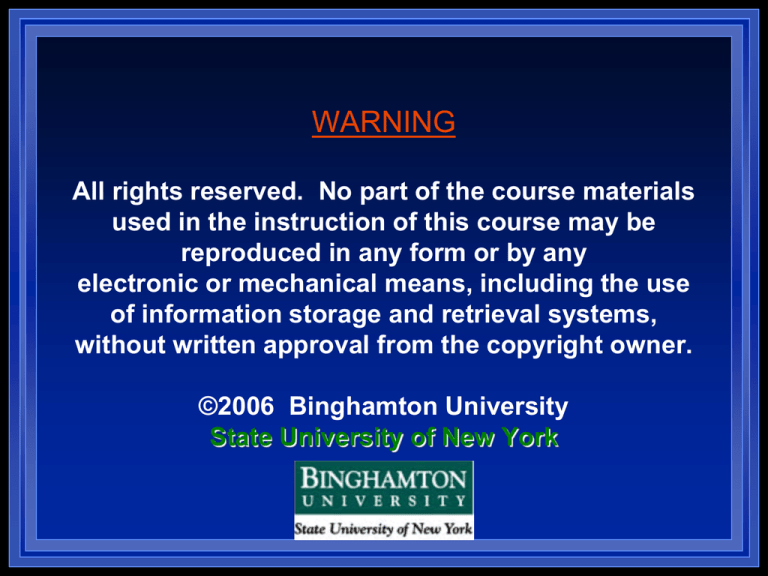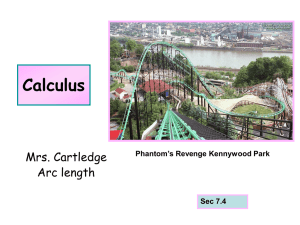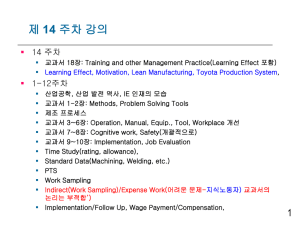
WARNING
All rights reserved. No part of the course materials
used in the instruction of this course may be
reproduced in any form or by any
electronic or mechanical means, including the use
of information storage and retrieval systems,
without written approval from the copyright owner.
©2006 Binghamton University
State University of New York
ISE 211
Engineering Economy
Cost Estimating
(continued)
Estimating Models (cont’d)
4) Power Sizing Model:
Used to estimate costs of industrial plants and
equipment
It “scales up” or “scales down” previously known
costs, thereby accounting for common “economic
scales”
Example: Building a refinery – would the cost to build the
same refinery with double the capacity be twice as much?
Answer:
Estimating Models (cont’d)
The Power Sizing Model
x
Where:
Cost of equipment A
Capacity of A
Cost of equipment B
Capacity of B
x – power sizing exponent (from Handbooks)
Cost of A and B are at the same time
Capacity is measured in the same units
Note: You may need to use both power sizing and costs indexes together to
account for capacity changes and time changes.
Example Power Sizing Exponent Values
Example
Based on her work in the previous example, Miriam has been asked
to estimate the cost today of a 2500 ft2 heat exchange system for the
new plant being analyzed. She has the following data:
Her company paid $50,000 for a 1000 ft2 heat exchanger 5
years ago
Heat exchangers within this range of capacity have a power
sizing exponent of 0.55.
The Heat Exchanger Cost Index (HECI) was 1306 five years
ago and is 1487 today.
Estimating Models (cont’d)
5) Learning Curves
As the number of repetitions increase the faster and more
accurate performance becomes -- “Learning and
Improvement”
They capture the relationship between task performance and
task repetition
In general, as output doubles, the time to do the task reduces
by some amount -- For a 95% learning curve: this means the
new time will be 95% of the old time.
Example: if it takes 300 minutes to make the 3rd item, how
long would it take to make the 6th item if it has a 95% learning
curve?
Solution:
Also called: progressive curve, improvement, experience
curve, etc.
Estimating Models (cont’d)
Expression for time estimating in repetitive tasks:
TN= Tinitial x Nb
Where TN -- time requirement for the Nth unit of production
Tinitial -- time requirement for the first/initial unit of production
N -- number of completed units (cumulative production)
b -- learning curve exponent (slope of the learning curve)
A learning curve is often referred to by its percentage learning
slope
A curve with b = -0.074 is a 95% learning curve: 2-0.074 = 0.95
This equation uses 2, because the learning curve percentage
applies for doubling cumulative production
The learning curve exponent can be calculated as follows:
b = log (learning curve expressed as a decimal)/log 2.0
Example 1
Calculate the time required to produce the
100th unit of a production run if the first
unit took 32.0 minutes to produce and the
learning curve rate for production is 80%.
Solution:
Example 2
Estimate the overall labor cost portion due to a
task that has a learning curve rate of 85% and
reaches a steady state value after 16 units of 5
minutes per unit. Labor and benefits are $22.00
per hour and the task requires two skilled
workers. The overall production run is 20 units.
Solution:
Example 2 (cont’d)
Estimating Benefits
Fixed and variable benefits, recurring and non-recurring
benefits, incremental benefits, etc
Benefits are more likely to be overestimated than under
estimated
Many of the models, concepts and issues that apply in
the estimation of costs also apply in the estimation of
economic benefits.
Cash Flow Diagram
The costs and benefits of engineering projects occur over time and
are summarized on a Cash Flow Diagram (CFD)
CFD illustrates the size, sign, and timing of individual cash flows
Categories Cash Flow
The expenses and receipts due to engineering projects usually fall
into one of the following categories:
1) First cost: expense to build or to buy and install
2) Operations and maintenance (O&M): annual expense, such
as electricity, labor, and minor repairs
3) Salvage value: receipt at project termination for sale or
transfer of the equipment (can be salvage cost)
4) Revenues: annual receipt due to sale of product or services
5) Overhaul: major capital expense expenditure that occurs
during the asset’s life
Drawing Cash Flow Diagrams with a Spreadsheet
Homework # 02 (Practice Problems)
2.3
2.4
2.8
2.12
2.17
2.18
2.20
2.24
2.27
2.28
2.31








